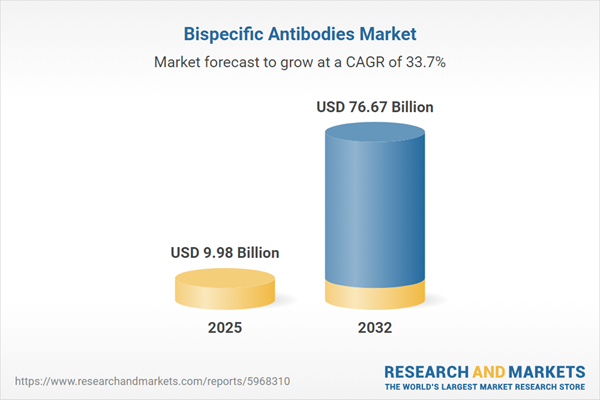Speak directly to the analyst to clarify any post sales queries you may have.
The bispecific antibodies market is experiencing dynamic transformation as innovation, clinical adoption, and evolving regulations redefine industry standards. Senior decision-makers face rising expectations for agility in operations and investment as they navigate the shifting landscape of this high-impact sector.
Market Snapshot: Bispecific Antibodies Market Size and Trajectory
Reaching a valuation of USD 7.49 billion in 2024 and forecasted to grow to USD 9.98 billion in 2025, the bispecific antibodies market demonstrates significant upward momentum with an anticipated size of USD 76.67 billion by 2032, underpinned by a compound annual growth rate of 33.72%. Expansion is attributed to positive regulatory environments fostering continual innovation, increased R&D investments, and diversification of clinical uses for bispecific antibodies. Therapeutic deployments now span oncology, autoimmune disorders, and infectious diseases, exemplifying strong sector integration. The maturation of commercialization strategies and technological platforms further accelerates patient access and responsiveness to market developments, making the bispecific antibodies market a focal point for competitive positioning.
Scope & Segmentation of the Bispecific Antibodies Market
A robust framework for market segmentation enables senior leaders to create differentiated strategies and tailor investments across diverse industry segments. Each segmentation point below represents a pivotal aspect of market structure, informing targeted portfolio development and partnership optimization.
- Mechanism of Action: This segment includes dual checkpoint inhibitors, receptor tyrosine kinase inhibitors, fusion proteins, and T cell engager platforms such as BiTE, DART, and TandAb, each supporting collaborative approaches and novel therapy designs within research and clinical pipelines.
- Structure: Encompasses IgG-like and non-IgG-like bispecific antibodies, allowing manufacturing flexibility and adaptation to both standardized and emerging treatment frameworks, which supports scalability and precise clinical application.
- Indication: Capabilities reach autoimmune diseases, cancer therapeutics, and infectious disease interventions, positioning developers to create solutions across multidisciplinary domains, thus promoting co-development and access strategies for varied patient populations.
- Technology Platforms: Integrates established approaches such as CrossMab, DuoBody, and knobs-into-holes to accelerate both rapid prototyping and scalable production against an evolving clinical trial environment.
- End User Segments: The market serves ambulatory care centers, hospitals, specialty clinics, and research organizations, each requiring distinct integration within localized care models and offering strategic alignment with operational needs and service demand.
- Regions: Addresses unique regulatory and commercial conditions across the Americas, Europe, Asia-Pacific, and Middle East & Africa, enabling risk-adjusted entry strategies and tailored expansion initiatives in diverse environments.
Key Takeaways: Strategic Insights for Senior Leaders
- Innovation in antibody engineering is expanding the development pipeline and simplifying regulatory compliance efforts, refocusing competitive strategy for sustainable growth amid a dynamic sector.
- Collaborative partnerships—spanning industry players and institutions—are accelerating research outputs, shortening the pathway from development to launch, and enhancing product distinctiveness within complex life sciences cycles.
- Active regulatory engagement offers organizations the opportunity to expedite approvals and expand product portfolios more efficiently, reinforcing the importance of dedicated compliance management.
- Implementing multidisciplinary care models, including integrated infusion clinics, supports efficient patient management and enhances treatment delivery outcomes.
- Diversified sourcing strategies and strong supplier relationships protect organizations from supply chain disruptions and improve continuity under volatile market conditions.
- The adoption of modular platform technologies enhances organizational responsiveness, enabling swift adaptation to emergent clinical, logistical, or production requirements.
Tariff Impact on Global Supply Chain and Pricing
Recent tariffs on essential input materials have prompted organizations within the bispecific antibodies market to review sourcing models and strengthen procurement flexibility. These responses aim to support cost management and negotiation capabilities during reimbursement discussions. By introducing risk-sharing agreements and value-based contracting, stakeholders are creating more resilient frameworks suited to fluctuations in international trade and supply continuity.
Methodology & Data Sources
Analysis integrates insights from sector experts, regulatory body guidelines, and leading peer-reviewed research. Continuous patent monitoring and direct B2B market research combine with active partnership tracking to ensure a current, comprehensive industry perspective.
Why This Report Matters
- Provides executive teams with actionable intelligence for agile strategic and operational shifts in a rapidly evolving market environment.
- Enables transparent identification of sector risks, new growth drivers, and changing collaboration landscapes—key to robust expansion and proactive procurement policy.
- Supplies compliance-oriented insights for implementing sustainable and risk-mitigated business practices tailored to the bispecific antibodies market.
Conclusion
Access to thorough intelligence empowers senior leaders to sharpen their strategic direction, improve operational resilience, and advance confidently in this rapidly evolving sector.
Additional Product Information:
- Purchase of this report includes 1 year online access with quarterly updates.
- This report can be updated on request. Please contact our Customer Experience team using the Ask a Question widget on our website.
Table of Contents
3. Executive Summary
4. Market Overview
7. Cumulative Impact of Artificial Intelligence 2025
Companies Mentioned
The companies profiled in this Bispecific Antibodies market report include:- F. Hoffmann-La Roche Ltd
- Amgen Inc.
- Janssen Biotech, Inc.
- Pfizer Inc.
- AbbVie Inc.
- Regeneron Pharmaceuticals, Inc.
- MacroGenics, Inc.
- AstraZeneca PLC
- Merck & Co., Inc.
- Genmab A/S
Table Information
| Report Attribute | Details |
|---|---|
| No. of Pages | 187 |
| Published | November 2025 |
| Forecast Period | 2025 - 2032 |
| Estimated Market Value ( USD | $ 9.98 Billion |
| Forecasted Market Value ( USD | $ 76.67 Billion |
| Compound Annual Growth Rate | 33.7% |
| Regions Covered | Global |
| No. of Companies Mentioned | 11 |









